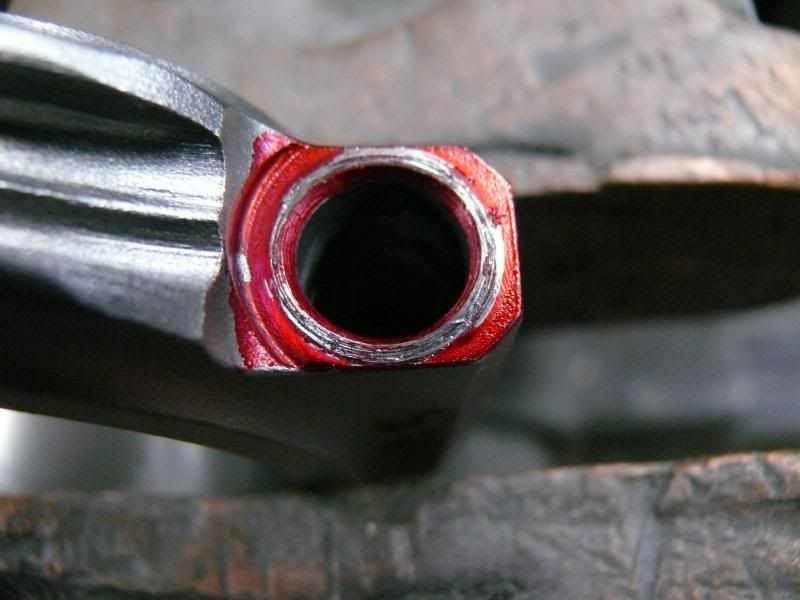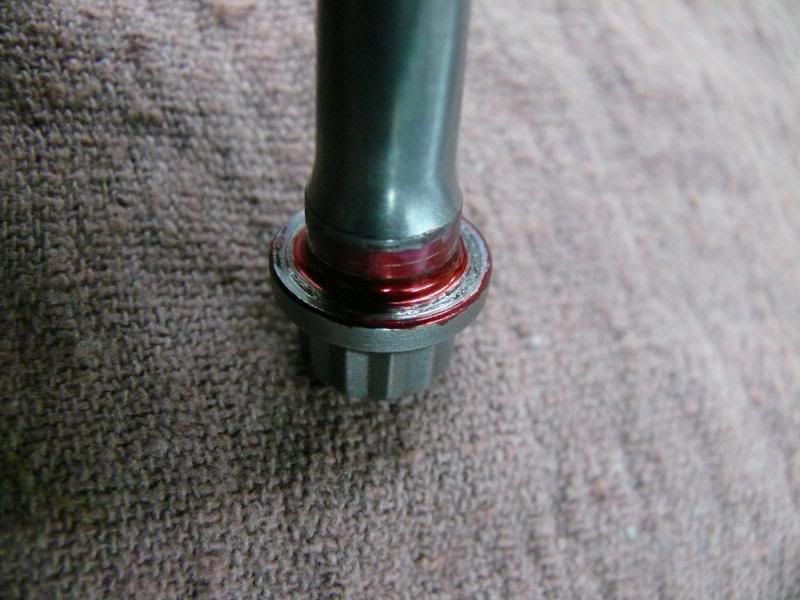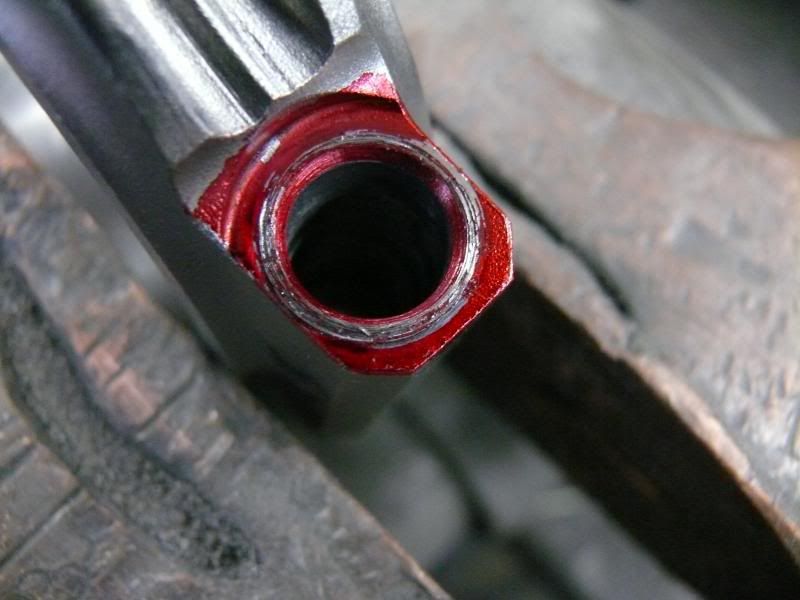| FAQ |
| Members List |
| Social Groups |
| Calendar |
| Search |
| Today's Posts |
|
#1
|
|||
|
|||
|
What do you guys think. Brand new Eagle forged rods, new ARP 2000 upgraded bolts, torque to bolt stretch of .0065/inches, used ARP supplied lube, take apart to install bearings, metal transfer on most of the rod caps.
Anybody ever seen this? Suggestions? (Note: red coloration is Dyekem as we originally thought the fastener fillet was rubbing the cap chamfer= it wasn't)   
__________________
1964 Catalina 2+2 4sp, 421 Tri-power 1965 GTO, Roadster Shop chassis, 461, Old Faithful cam, KRE heads 305 CFM, Holley EFI, DIS ignition. 1969 GTO 467, Edelbrock 325 CFM, Terminator EFI 1969 Firebird Convertible |
|
#2
|
||||
|
||||
|
Galling. It can be caused by inadequate lubrication during the torque process, or many other specific possibilities, like high spots that cause friction. I'm no metallurgist, but I wouldn't be surprised if the hardness is not within specification. I think it will happen to some extent any time a high strength nut contacts softer metal that is being clamped through the torque process, with the degree of "galling" dependent on the quality of the parts, and lubrication.
__________________
1969 Firebird, Tx3-455/468 machined by CVMS E-heads by Dave Wilcox/Comp Cams 300B-6 flat solid 850DP on E-85 by Eric Niefert/T2 1" plastic spacer T-400/PTC 4000/390's/30x9 Hoosier radial slicks,#3400 1.38 60' 6.32 @ 108 MPH at Northeast Dragway NC 5/23/15 (9th pass on new engine) https://m.youtube.com/watch?v=ePCu2v...ature=youtu.be 1.37 60' 6.26 @ 109 half track, 9.86 @ 136 1/4 mile, #3350 11/26/16 at Richmond Dragway (125th pass on new engine) |
|
#3
|
||||
|
||||
|
Any rod bolt is going to be way the hell harder than the rod its loaded into, I prefere to use a syth oil under the rod bolt head.
I would try and get that surface spot faced and use oil next time.
__________________
Wernher Von Braun warned before his retirement from NASA back in 1972, that the next world war would be against the ETs! And he was not talking about 1/8 or 1/4 mile ETs! 1) 1940s 100% silver 4 cup tea server set. Two dry rotted 14 x 10 Micky Thompson slicks. 1) un-mailed in gift coupon from a 1972 box of corn flakes. Two pairs of brown leather flip flops, never seen more then 2 mph. Education is what your left with once you forget things! |
|
#4
|
|||
|
|||
|
Did a little searching on the internet after reading your post and there are numerous posts from Eagle users with all kinds of engines with this same concern. I assume these fasteners do not come with torquing washers? That would be my first concern, Generally, when torquing a high strength, high load fastener, they would use a torquing washer with an inside chamfer and both sides of the washer would be lubed as well as underhead of the bolt. I am not surprised by what I see without a washer used. For your piece of mind, you might want to call ARP directly and ask them about using their fastener on Eagle rods without washers. The folks I have dealt with at Eagle, Probe and the other Chinese vendors has been pretty spotty. Most don't have any real technical training and are lucky to parrot the usual"we have been selling/using them for years with no complaints". That really doesn't address your concern. In summary, if there is enough thread engagement, I would use washers. There may not be and that is why they were deleted. Having the fastener sitting on raised, galled metal will effect it's clamp load.
|
|
#5
|
||||
|
||||
|
I use ARP lube under the bolt head. By the time I finish a motor the rods are bolted and unbolted 3x and I have never seen any galling with ARP bolts, just relating my experience.
__________________
1967 Firechicken, 499", Edl heads, 262/266@0.050" duration and 0.627"/0.643 lift SR cam, 3.90 gear, 28" tire, 3550#. 10.01@134.3 mph with a 1.45 60'. Still WAY under the rollbar rule. |
|
#6
|
||||
|
||||
|
Call me old but i still use thin coat of 30w oil.
Know lot of guys around here swear by Moroso moly paste assembly lube.
__________________
If you cant drive from gas pump to gas pump across the map, its not a street car. http://s207.photobucket.com/albums/b...hop/?start=100 |
|
#7
|
||||
|
||||
|
What rods? Cap screws or nuts on bolts? With/without washers?
__________________
Anybody else on this planet campaign a M/T hemi Pontiac for eleven seasons? ... or has built a record breaking DOHC hemi four cylinder Pontiac? ... or has driven a couple laps of Nuerburgring with Tri-Power Pontiac power?(back in 1967) |
|
#8
|
||||
|
||||
|
I have used Eagle rods for years and always used ARP lube liberally on the threads shank and under the head and have never had a problem like that. If the fasteners were lubed properly and you have galling like that I would say you have a bad set of rods. But once there is any galling on the rod you can't use it again.
__________________
Tim Corcoran |
|
#9
|
||||
|
||||
|
Eagle rods with cap screws and no washers. Crower rods with cap screw and no washers.
__________________
1967 Firechicken, 499", Edl heads, 262/266@0.050" duration and 0.627"/0.643 lift SR cam, 3.90 gear, 28" tire, 3550#. 10.01@134.3 mph with a 1.45 60'. Still WAY under the rollbar rule. |
|
#10
|
||||
|
||||
|
Maybe the Bolthead contact Surface area is so low to promote Friction-weld (based on high PSI & rotational friction)?
Would say the bolt head (or/and the Rod padflatness) has a design issue? Or a design feature depending on how you look at it. The issue becomes feature if the bolt achieved 0.0065"stretch. Can you access the rodbolt end inside the rod to measure stretch? |
|
#11
|
|||
|
|||
|
Yes, we were able to fit the ARP bolt stretch indicator fixture inside the rod to measure bolt stretch. We saw .0065/inches at about 80 ft/lbs torque. Eagle spec is 75 ft/lbs torque, .0065/.0068/inches stretch.
Not sure what to do now, but I cannot see using these rods.
__________________
1964 Catalina 2+2 4sp, 421 Tri-power 1965 GTO, Roadster Shop chassis, 461, Old Faithful cam, KRE heads 305 CFM, Holley EFI, DIS ignition. 1969 GTO 467, Edelbrock 325 CFM, Terminator EFI 1969 Firebird Convertible |
|
#12
|
||||
|
||||
|
Id call Eagle and then send back to have hardness checked - both rod and bolt - I use the ARP ultra lube and no problems - but not with eagle.
|
|
#13
|
||||
|
||||
|
You're seeing galling at the cap/bolt interface. The most likely cause is poor lubrication of the joint during the torquing sequence or the surface not being smooth. The contact pattern looks reasonable and the there is no contact on the underhead radius which is a good thing. The galling may look bad but it should not hurt anything. I'd be worried about galling reducing the underhead friction during torquing which can lower bolt loads for a given torque level. However, you have demonstrated you're able to obtain the correct bolt stretch on the joint. As long as the bolts are ok on strength, you won't have any trouble. I'd run them.
Galling can cause real trouble between main caps and blocks or between rod caps and rods. This is a sign of relative motion at the joint caused by lack of clamp load. Galling can cause a reduction of clamp load over time which can lead to bolt fatigue and failure of the bolts. |
|
#14
|
||||
|
||||
|
Quote:
__________________
1969 Firebird, Tx3-455/468 machined by CVMS E-heads by Dave Wilcox/Comp Cams 300B-6 flat solid 850DP on E-85 by Eric Niefert/T2 1" plastic spacer T-400/PTC 4000/390's/30x9 Hoosier radial slicks,#3400 1.38 60' 6.32 @ 108 MPH at Northeast Dragway NC 5/23/15 (9th pass on new engine) https://m.youtube.com/watch?v=ePCu2v...ature=youtu.be 1.37 60' 6.26 @ 109 half track, 9.86 @ 136 1/4 mile, #3350 11/26/16 at Richmond Dragway (125th pass on new engine) |
|
#15
|
|||
|
|||
|
IIRC ARP suggested stretch number is amount of stretch from relaxed(no load) and their suggested lube. If you use ARP fasteners you use their tightening instruction. They have it pretty scienced out. If ARP suggests a specific torque procedure follow it. If they say 50 lbs set at 50 lbs not 45 not 55.(I cringe when I read someone suggesting a torque setting above or below the bolt companies suggestion. Deviating from their spec is an invitation to something going wrong.) Same with stretch method set to nominal spec and do it in the manner they suggest. If any doubt call them not the rod or main cap company.
In general... when using stretch method both ends of bolt need "dimples" so you have a repeatable placement of the stretch gauge. Measure unstretched and measure the stretch as you tighten it till you've stretched it proper amount. A box wrench is useful here as you dont have to remove the gauge.(I use an offset 12 point which isnt as fast as a socket but I dont have to worry that stretch gauge has been moved which could cause an error.) You can check for bolt fatigue if you measured your "dimpled" bolts before using them and recorded their length and placement. Anytime you remove the "torque" measure the relaxed length...it should return to original unloaded measurement if it hasnt fatigued.(and temp is relatively the same as when you measured originally). I'm a big believer in hardened washers under any nut if at all possible. |
|
#16
|
||||
|
||||
|
Fixed it. Should have said increasing not reducing friction. I nust have been in a hurry with brain not engaged. Sorry
Quote:
|
|
#17
|
||||
|
||||
|
Correct. Once again running too fast without brain engaged. Thanks for the correction!
|
|
#18
|
||||
|
||||
|
I'm glad this thread was started because i was planning eagle rods for my next build.
Adding to this conversation for clarity, not directed towards any particular reader. Galling- is a result of movement, with the movement an intended function or part of the design. In this case the bolt head turning. Fretting- is movement that is not a part of the design or intended function, meaning the part is not supposed to move. Upon teardown of my last engine, several main-bearing cap/block interface locations exhibited fretting. I agree with Bruce, using a hardened washer to provide a smooth bearing surface is good, but how many people would put a washer under a connecting rod bolt-head, that did not come with the rod? I'll post a couple pics of my crower rods that were in service for over seven years (1000+ passes) for comparison purposes.
__________________
1969 Firebird, Tx3-455/468 machined by CVMS E-heads by Dave Wilcox/Comp Cams 300B-6 flat solid 850DP on E-85 by Eric Niefert/T2 1" plastic spacer T-400/PTC 4000/390's/30x9 Hoosier radial slicks,#3400 1.38 60' 6.32 @ 108 MPH at Northeast Dragway NC 5/23/15 (9th pass on new engine) https://m.youtube.com/watch?v=ePCu2v...ature=youtu.be 1.37 60' 6.26 @ 109 half track, 9.86 @ 136 1/4 mile, #3350 11/26/16 at Richmond Dragway (125th pass on new engine) |
|
#19
|
||||
|
||||
|
Regardless of the hardness of the galled rod cap, I believe an uneven surface with high spots on the bearing surface (bolt-cap interface), created friction and contributed to your galled surface. My crower rods look to be well finished, but its hard to tell if the eagle rod was well finished, due to the red dyekem and galled surface. What do new eagle rods look like in this area? Are they well finished, with a surface that is smooth?
__________________
1969 Firebird, Tx3-455/468 machined by CVMS E-heads by Dave Wilcox/Comp Cams 300B-6 flat solid 850DP on E-85 by Eric Niefert/T2 1" plastic spacer T-400/PTC 4000/390's/30x9 Hoosier radial slicks,#3400 1.38 60' 6.32 @ 108 MPH at Northeast Dragway NC 5/23/15 (9th pass on new engine) https://m.youtube.com/watch?v=ePCu2v...ature=youtu.be 1.37 60' 6.26 @ 109 half track, 9.86 @ 136 1/4 mile, #3350 11/26/16 at Richmond Dragway (125th pass on new engine) Last edited by 455firebird1969; 09-14-2013 at 10:20 AM. |
|
#20
|
||||
|
||||
|
Quote:
Tom Vaught
__________________
"Engineers do stuff for reasons" Tom Vaught Despite small distractions, there are those who will go Forward, Learning, Sharing Knowledge, Doing what they can to help others move forward. |
| Reply |
|
|